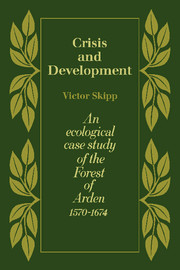Book contents
- Frontmatter
- Contents
- List of figures
- List of tables
- Acknowledgements
- PART ONE THE CONTEXT
- PART TWO THE CASE STUDY
- 4 The demographic crisis of 1613–19
- 5 Negative responses
- 6 The ecological problem
- 7 Positive responses: agrarian change
- 8 Positive responses: new employment openings
- 9 Model of demographic, economic and social developments, 1575–1649
- 10 The new ecological regime, 1625–74
- 11 The social cost
- PART THREE IMPLICATIONS
- Appendix 1 The practice of birth control
- Appendix II Estimates of population size
- Notes
- Index
4 - The demographic crisis of 1613–19
Published online by Cambridge University Press: 05 November 2011
- Frontmatter
- Contents
- List of figures
- List of tables
- Acknowledgements
- PART ONE THE CONTEXT
- PART TWO THE CASE STUDY
- 4 The demographic crisis of 1613–19
- 5 Negative responses
- 6 The ecological problem
- 7 Positive responses: agrarian change
- 8 Positive responses: new employment openings
- 9 Model of demographic, economic and social developments, 1575–1649
- 10 The new ecological regime, 1625–74
- 11 The social cost
- PART THREE IMPLICATIONS
- Appendix 1 The practice of birth control
- Appendix II Estimates of population size
- Notes
- Index
Summary
Detailed work on the demography of the five parishes has shown that, although there was an overall population increase of about 50% between the 1570s and the 1640s, the advance was by no means steady and uninterrupted. During the last quarter of the sixteenth century the rate of natural increase (i.e., the extent to which baptisms exceeded burials) was 45%. It fell during the first quarter of the seventeenth century to 21%, but rose in the second quarter to the exceptionally high figure of 62%.
The demographic rates derived from family reconstitution exhibit parallel tendencies (Table I and Fig. 3). Closed family size averaged 3.5 children among parents marrying in the period 1575–99, completed family size 4.5. These figures dropped to 2.9 and 4.1 children respectively among those marrying between 1600 and 1624; then went up to 3.7 and 4.4 among those marrying in the period 1625–49. The average childbearing span, and also the average life expectation at marriage, follow a similar pattern, both being significantly shorter in the middle of the three periods. From this it would appear that fertility was relatively high and mortality relatively low in the generations marrying in the periods 1575–99 and 1625– 49, whereas in the 1600–24 generation the reverse applied.
- Type
- Chapter
- Information
- Crisis and DevelopmentAn Ecological Case Study of the Forest of Arden 1570–1674, pp. 13 - 38Publisher: Cambridge University PressPrint publication year: 1978
- 1
- Cited by



